11 Best Performance Testing Tools for Your WordPress Website

Performance testing is essential for ensuring your website works without fault. When someone visits your site, they expect fast loading times as well as excellent website stability. So, no matter how insignificant an error may seem, any software hiccup can make your site look unprofessional and negatively affect user experience and website rankings.
When you wish to check if your software has any glitches, there are several types of performance tests you could do. The most common ones include load testing (checking how your software performs under the expected workload volume in a given time), stress testing (pushing the website above its limit and subjecting it to extreme workloads to determine its stability), spike testing (verifying how and if the website can handle large and sudden volume increases), endurance a.k.a. soak testing (evaluating how the software performs under the regular volume over an extended period of time), volume a.k.a. flood testing (checking the software performance when handling a large volume of data), and scalability testing (analyzing the software behavior when the number of user requests increases or decreases and determining up to what amount of load the software can be scaled).
The best way to carry out performance tests of your WordPress website is to use a performance testing tool. Before your site goes live, we suggest you evaluate the performance of your software by using any of the following tools:
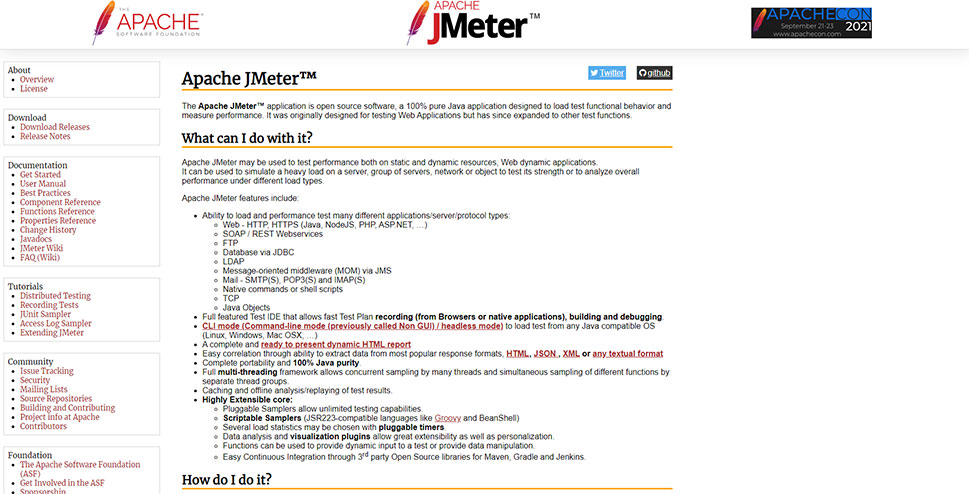
Apache JMeter is a popular testing tool based on Java. You can use it free of charge to create an automated load script and generate as much load as you want to test the performance of your WordPress website.
Apache JMeter enables you to simulate heavy workloads from any operating system, be it Windows, macOS, Linux, etc. You can test how your website deals well with heavy transactions, heavy browsing, etc. Moreover, you can use it to create extreme loads on a network, one server, or on a group of several different servers to test the stability of your software and see how well it performs in challenging conditions.
Once the testing is complete, the results are displayed on graphs and charts. You get all the data you need to understand if any areas of your software need improving. The ApacheJMEter tool has a multi-threading framework, meaning you can create multiple threads within one process and simultaneously sample several functions by separate thread groups. The functionalities of the Apache JMeter’s core can be extended with scriptable samplers (e.g., Groovy and BeanShell), pluggable samplers, pluggable timers, as well as with visualization plugins. Apache JMeter is an open-source tool and as such, it integrates with open-source libraries such as Jenkins, Maven, Gradle, and others.
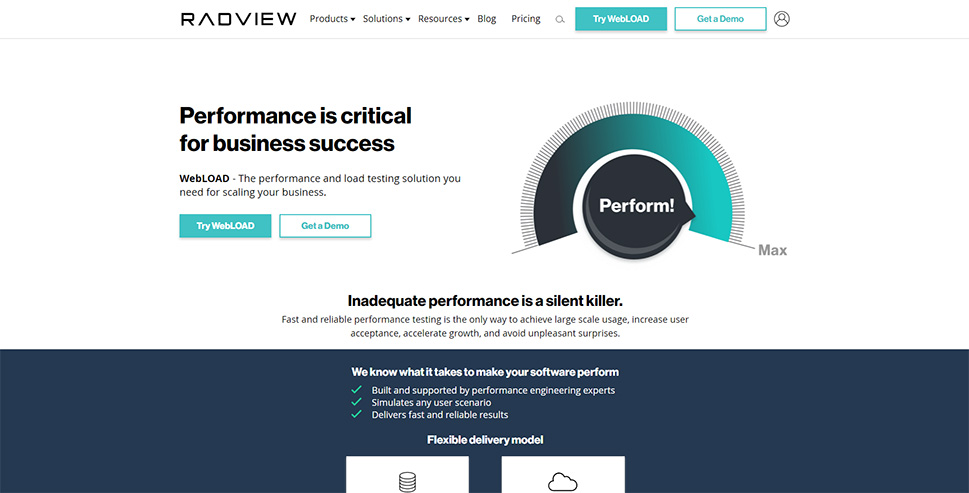
WebLOAD is a terrific performance and load testing tool. You can first get the trial version and test the software for up to 50 virtual users, and if you happen to like the tool, you can choose a pricing plan that meets your needs.
With WebLOAD, you can simulate thousands of users visiting your site from different locations at the same time, but also perform cloud load testing and continuous testing. Moreover, you can set specific performance goals for your website (e.g., test it to see if it loads in under 2 seconds) and set the fail/pass criteria. Your scenario will load in JavaScript, which allows you to make modifications to the scenario according to your requirements. WebLOAD uses a tool called the Integrated Development Environment (IDE), which allows you to edit test scripts in two modes – using the Visual Editing mode and the JavaScript Editing mode.
When you’re done testing, you will get 80 practical reports with graphs that enable you to identify the weak spots of your software.
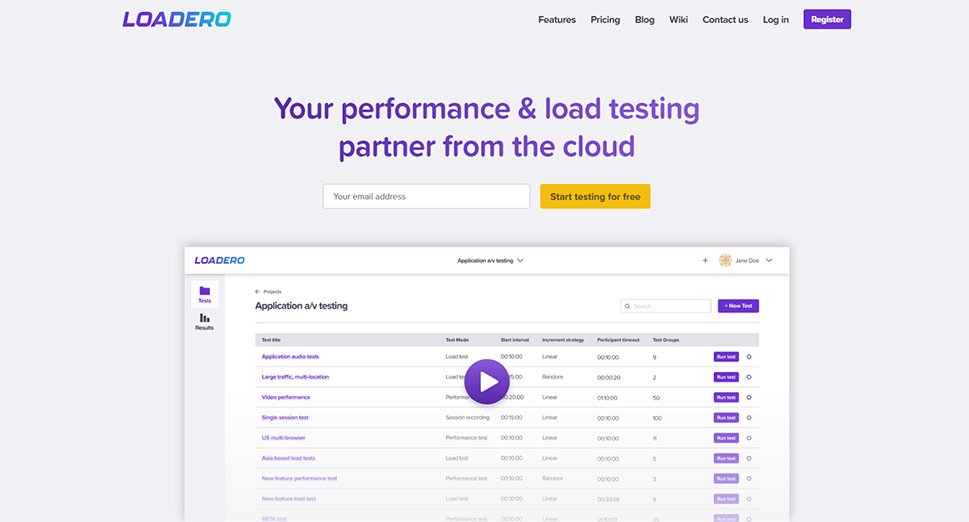
Loadero is another great cloud-based performance testing tool that allows you to run performance and load tests. You can try it for free, but to conduct large tests that include 20.000 virtual users and more, you have to purchase one of the four available pricing plans.
With Loadero, you can create test scripts in Selenium and JavaScript. It is possible to run tests on Google Chrome and Mozilla Firefox, add fake media elements to simulate the use of microphones and webcams, test the software in different network conditions as well as on 12 locations across the globe. The tool also includes built-in validations which allow it to automatically execute predefined assertions once the testing is over.
And lastly, you get an in-depth analysis of the software performance enabling you to pinpoint and improve problematic software areas.
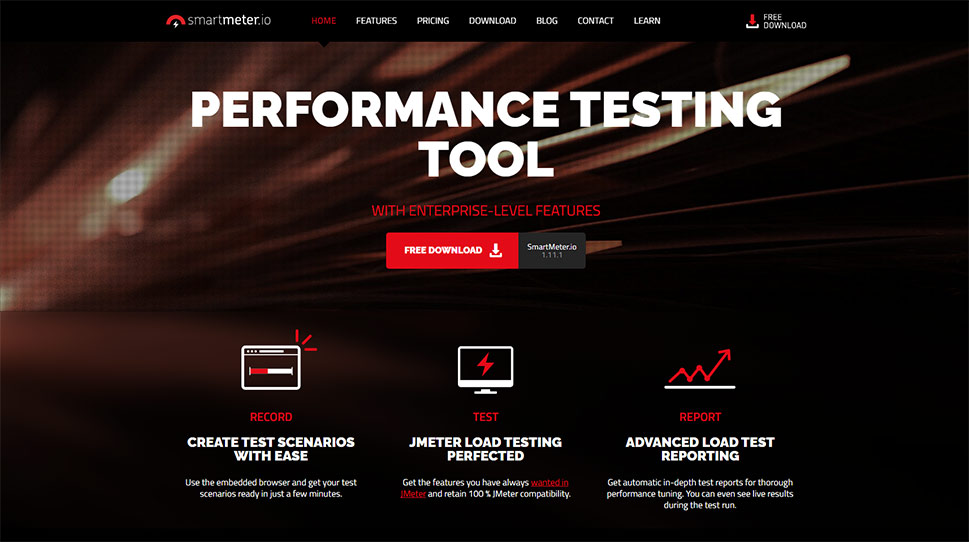
SmartMeter is a good choice if you’re looking for a performance tool with enterprise-level features. There are several pricing plans available – the most affordable package costs $39 per month.
You can easily create testing scenarios to your liking. SmartMeter enables you to simulate as many virtual users from as many locations as you wish, specify the maximum response time as well as the number of errors to be tolerated, and set success criteria. You can also separate static from dynamic resources and record logs. Furthermore, it is possible to observe results in real-time. SmartMeter also provides you with an in-depth analysis of your software’s performance so you can immediately spot problematic elements and start working on resolving them.

k6 is an open-source performance tool “built for engineering teams”. At the moment, there are four pricing plans you can choose from but it’s also possible to use the free version for up to 50 virtual users.
Just like all the other tools on the list, this one, too, lets you check the performance of your software by devising particular scenarios. Depending on the package you purchase, you have the option to determine the duration of the test, see results in the near real-time, but also contact the k6’s team and ask them to guide you through the testing process. Testing scripts are written in JavaScript, which allows web developers to manipulate scenarios as per their needs.
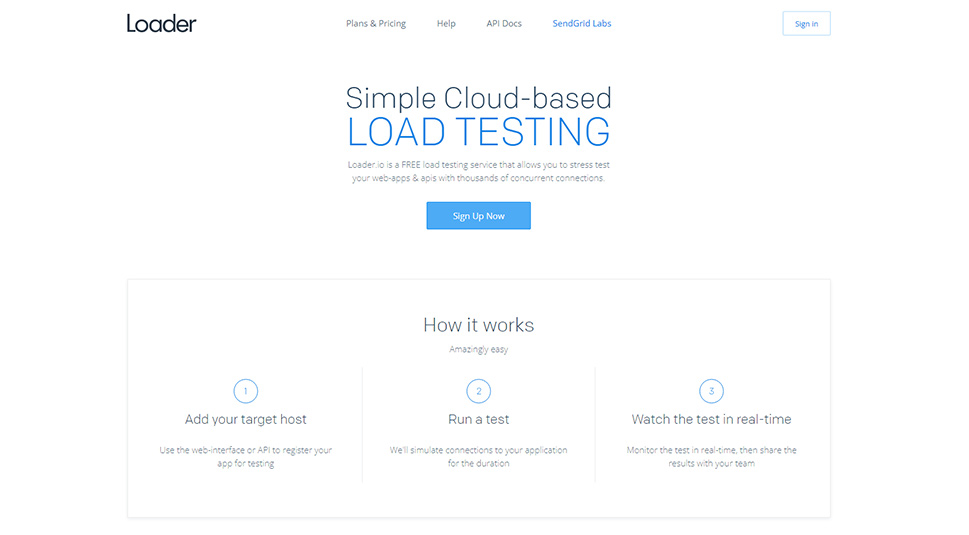
Loader.io is a cloud-based tool that enables you to load and stress-test the APIs (Application Programming Interface i.e., an intermediary that allows two pieces of software to communicate) of your WordPress website. You can use the free version of the tool to test the software on up to 10.000 virtual users but that number increases to 100.000 if you get the pro plan (it currently costs $99.95).
The tool is easy to use – all you need to do is enter your APIs and register for testing, run tests, and watch the results in real-time. The built-in advanced analytics system provides you with a detailed overview of the performance, complete with useful graphs and statistics. You can access the results whenever you want and if you wish, you can share them with others.
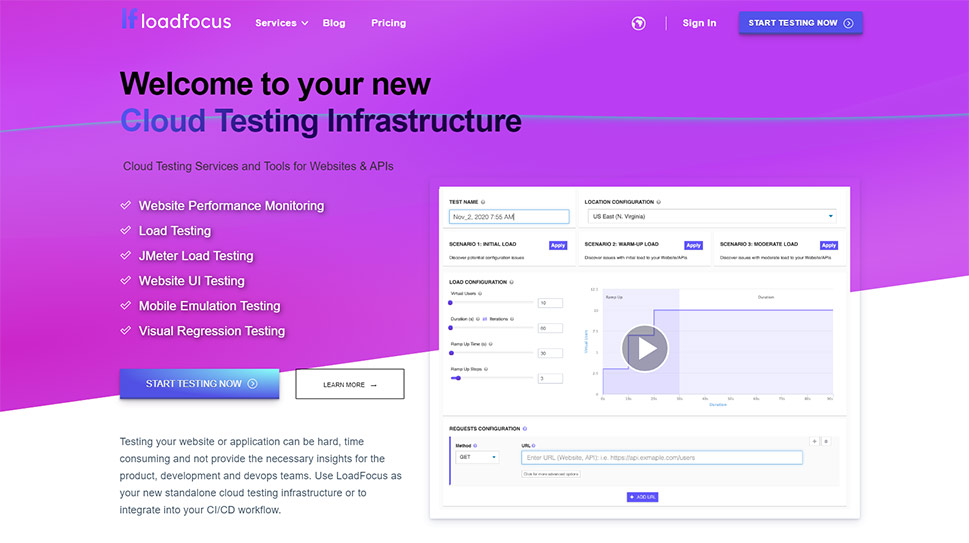
LoadFocus is a cloud-based tool that allows you to load test your website as well as to monitor APIs. There are three premium plans available, but you can also try the free version first, to check if the tool meets your demands. LoadFocus also offers the possibility of installing an extension for Google Chrome which enables you to create and run load, speed, and API tests for free.
With LoadFocus, you can scale realistic load tests and see how your software performs when thousands of virtual users from multiple regions visit it. You also get to specify the duration of the test. This option is particularly helpful if you want to check how the software behaves when a specific number of users visit the site over a predefined period of time.
The results are displayed in real-time, meaning you can spot performance changes straight away. This is particularly helpful when you’re changing testing parameters several times. You also get an in-depth analysis of the performance with errors and potential issues explained.
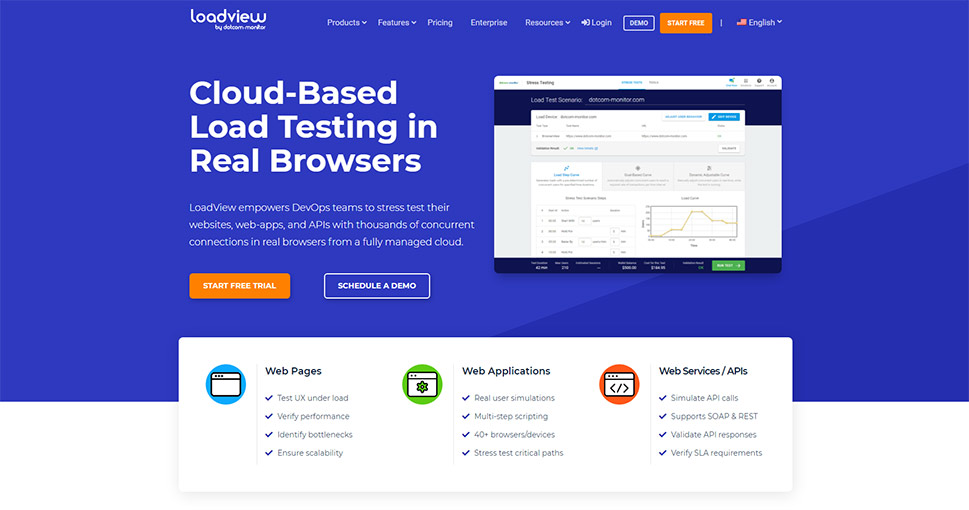
LoadView is another cloud-based enterprise-level tool intended for developers. It allows them to stress test the performance of software and APIs in real browsers. You can start for free and then choose a pricing plan that fits your requirements and the budget. The cheapest plan costs $199 and lets you test the software performance on up to 1000 virtual users whereas the “On Demand” plan grants the possibility of checking the performance with up to 1 million concurrent users.
With LoadView, you can specify the number of users and their location (20 locations are available), simulate the most common user interactions on a page, define the duration of the test, use dynamic variables (e.g., a list with usernames and passwords that clients would need to use to log onto the site), and specify the number of users per server. All tests are recorded on a video, allowing you to review the performance of your software anytime.
The LoadView tool provides you with detailed statistics and lets you keep track of the average response time for all locations. You can also observe the results in real-time. The more you are aware of your software’s performance, the easier it will be for you to hone it and prepare it for traffic spikes. And in case you need assistance with using the tool, a technical support team is at your disposal 24/7.
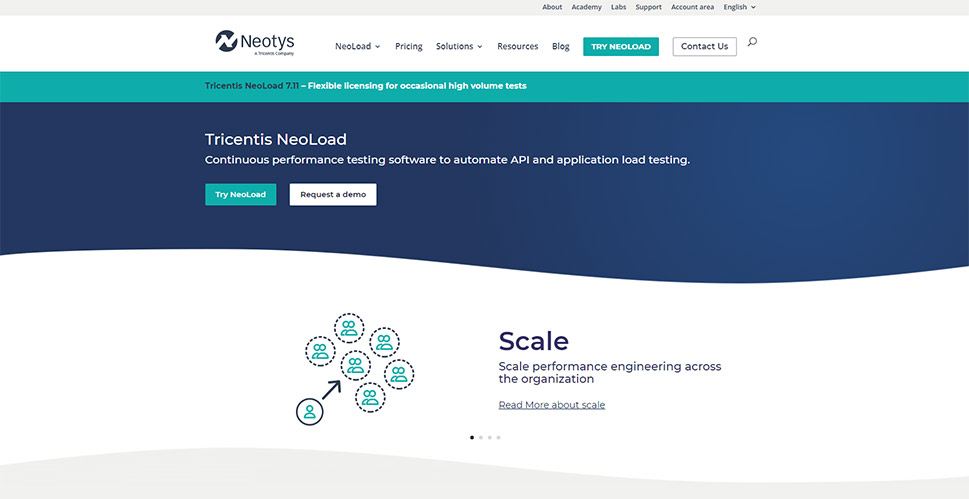
NeoLoad is an automated stress and load performance testing tool intended for enterprises. You can use it to continuously test your website’s APIs. The platform comes with a flexible pricing plan and you have to contact NeoLoad’s team to get the plan tailored to your needs.
The platform offers the possibility of simulating realistic user behavior and business processes on a site. Creating tests is easy and intuitive since the platform includes drag-and-drop controls. If you want to create some advanced testing scenarios, you can write scripts in JavaScripts, but in most cases, that’s not necessary as NeoLoad offers a myriad of testing options. You can easily update test scripts as well, but if you need help in that regard, you can check out the Script Update wizard that will lead you through the process of adding, merging, or deleting script elements. The tool also supports REST API testing.
NeoLoad provides you with real-time results, so you can see right away which elements need improvement.
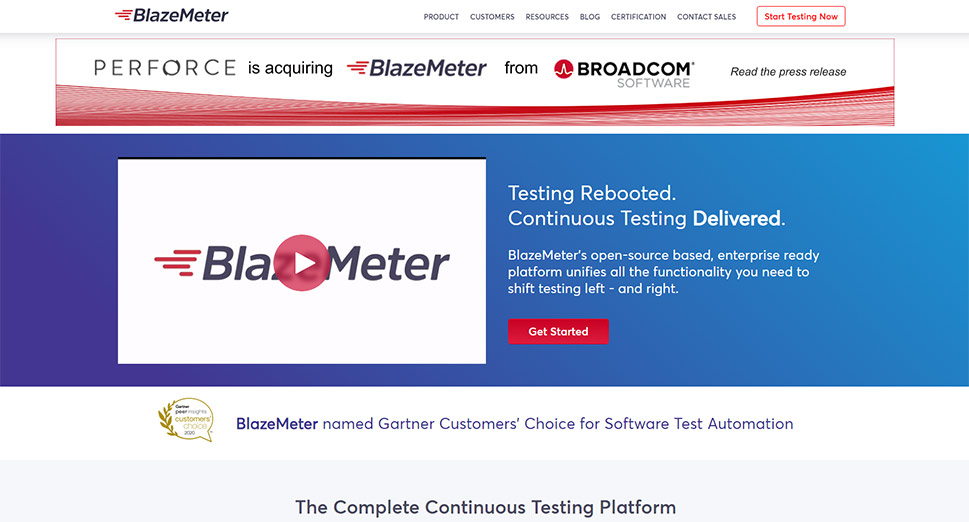
BlazeMeter is an open-source-based and enterprise-ready tool for shift testing. You can use it for free for up to 50 concurrent users, but there are three more premium plans to choose from.
You can effortlessly create new test scripts as well as reuse existing scripts to regularly control the performance of your software. You have the possibility to simulate up to 5000 virtual users (or more if you get the “Unleashed” plan) from more than 50 locations across the world. Depending on the plan you acquire, tests can run from 20 minutes to 5 hours (the “Unleashed” plan allows you to customize the duration yourself). You can also specify the number of hits per second, monitor APIs, choose the preferred cloud provider, as well as test on your private network or your own cloud.
Testing results are displayed on interactive graphs. It’s also possible to create Comparison Reports which enable you to keep track of performance changes over time.

LoadNinja is a practical platform that helps you reduce testing times. There are four pricing available, with the number of concurrent users per test ranging from 100 to 2500 (or more if you get the “Enterprise” plan).
LoadNinja doesn’t require any coding for test creation because it packs the AI-enhanced InstaPlay recorder. Thanks to that tool, you can devise tests in mere minutes no matter how complex they may be. Furthermore, LoadNinja includes the TrueLoad technology which allows you to load tests on real browsers and analyze the end-user experience. You can generate loads from locations in different parts of the world and also simulate realistic loads on your API layers. With LoadNinja, you can easily create any kind of scenario you want to test the behavior of your software.
Performance statistics are available in real-time, helping you understand the way your APIs work and if there are any performance bottlenecks you should be aware of.
Closing Words
Performance testing is essential for feeling the pulse of your site. The more you are aware of how well your website works and by continuously enhancing its performance, the better for your business. Why risk losing leads and having high bounce rates as well as poor SEO rankings? You can avoid that altogether and ensure good UX for your audience by using any of the suggested performance testing tools. Take a look at what each of them offers and choose the one that best fits your requirements. When possible, consider trying free plans to be certain a performance tool packs just the options you need. Of course, the price might be an important factor to influence your decision, but there are some quite affordable tools and plans on the list that pack a lot of value for the money. One thing’s for certain – no matter which platform you choose, the testing is a surefire way of discovering if your software needs improving.



